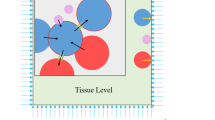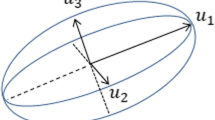Abstract
Cancer invasion and migration play a pivotal role in tumor malignancy, which is a major cause of most cancer deaths. Rotating magnetic field (RMF), one of the typical dynamic magnetic fields, can exert substantial mechanical influence on cells. However, studying the effects of RMF on cell is challenging due to its complex parameters, such as variation of magnetic field intensity and direction. Here, we developed a systematic simulation method to explore the influence of RMF on tumor invasion and migration, including a finite element method (FEM) model and a cell-based hybrid numerical model. Coupling with the data of magnetic field from FEM, the cell-based hybrid numerical model was established to simulate the tumor cell invasion and migration. This model employed partial differential equations (PDEs) and finite difference method to depict cellular activities and solve these equations in a discrete system. PDEs were used to depict cell activities, and finite difference method was used to solve the equations in discrete system. As a result, this study provides valuable insights into the potential applications of RMF in tumor treatment, and a series of in vitro experiments were performed to verify the simulation results, demonstrating the model's reliability and its capacity to predict experimental outcomes and identify pertinent factors. Furthermore, these findings shed new light on the mechanical and chemical interplay between cells and the ECM, offering new insights and providing a novel foundation for both experimental and theoretical advancements in tumor treatment by using RMF.






Similar content being viewed by others
Data availability
No datasets were generated or analyzed during the current study.
References
Anderson ARA, Chaplain MAJ, Newman EL, Steele RJC, Thompson AM (2000) Mathematical modelling of tumour invasion and metastasis. J Theoret Med 2:129–154. https://doi.org/10.1080/10273660008833042
Carrasco-Mantis A, Randelovic T, Castro-Abril H, Ochoa I, Doblare M, Sanz-Herrera JA (2023) A mechanobiological model for tumor spheroid evolution with application to glioblastoma: a continuum multiphysics approach. Comput Biol Med 159:106897. https://doi.org/10.1016/j.compbiomed.2023.106897
Chaffer CL, Weinberg RA (2011) A perspective on cancer cell metastasis. Science 331:1559–1564. https://doi.org/10.1126/science.1203543
Chai J, Hu J, Wang T, Bao X, Luan J, Wang Y (2024) A multifunctional liposome for synergistic chemotherapy with ferroptosis activation of triple-negative breast cancer. Mol Pharm 21:781–790. https://doi.org/10.1021/acs.molpharmaceut.3c00903
Chang-Qing Y et al (2020) Recent treatment progress of triple negative breast cancer. Prog Biophys Mol Biol 151:40–53. https://doi.org/10.1016/j.pbiomolbio.2019.11.007
Chaplain M, Lolas G (2005) Mathematical modelling of cancer cell invasion of tissue: the role of the urokinase plasminogen activation system. Math Models Methods Appl Sci 15:1685–1734. https://doi.org/10.1142/S0218202505000947
Chen H, Cai Y, Chen Q, Li Z (2020) Multiscale modeling of solid stress and tumor cell invasion in response to dynamic mechanical microenvironment. Biomech Model Mechanobiol 19:577–590. https://doi.org/10.1007/s10237-019-01231-4
Colombi A, Scianna M, Preziosi L (2015) A measure-theoretic model for collective cell migration and aggregation. Math Model Nat Phenom 10:4–35. https://doi.org/10.1051/mmnp/201510101
Franssen LC, Lorenzi T, Burgess AEF, Chaplain MAJ (2019) A mathematical framework for modelling the metastatic spread of cancer. Bull Math Biol 81:1965–2010. https://doi.org/10.1007/s11538-019-00597-x
Kauffmann P et al (2011) Diamagnetically trapped arrays of living cells above micromagnets. Lab Chip 11:3153–3161. https://doi.org/10.1039/c1lc20232d
Kim C et al (2018) Chemoresistance evolution in triple-negative breast cancer delineated by single-cell sequencing. Cell 173:879-893.e813. https://doi.org/10.1016/j.cell.2018.03.041
Liu F, Heiner M, Gilbert D (2022) Hybrid modelling of biological systems: current progress and future prospects. Br Bioinform. https://doi.org/10.1093/bib/bbac081
Liu X et al (2022) Exosomes deliver lncRNA DARS-AS1 siRNA to inhibit chronic unpredictable mild stress-induced TNBC metastasis. Cancer Lett 543:215781. https://doi.org/10.1016/j.canlet.2022.215781
Marchant B, Norbury J, Byrne H (2006) Biphasic behaviour in malignant invasion. Math Med Biol: J IMA 23:173–196. https://doi.org/10.1093/imammb/dql007
Mohammadi V, Dehghan M (2020) Generalized moving least squares approximation for the solution of local and non-local models of cancer cell invasion of tissue under the effect of adhesion in one- and two-dimensional spaces. Comput Biol Med 124:103803. https://doi.org/10.1016/j.compbiomed.2020.103803
Pahle J (2009) Biochemical simulations: stochastic, approximate stochastic and hybrid approaches. Br Bioinform 10:53–64. https://doi.org/10.1093/bib/bbn050
Perumpanani AJ, Sherratt JA, Norbury J, Byrne H (1996) Biological inferences from a mathematical model of malignant invasion. Invasion Metastasis 16:209–221
Price JT, Thompson EW (2002) Mechanisms of tumour invasion and metastasis: emerging targets for therapy. Expert Opin Ther Targets 6:217–233. https://doi.org/10.1517/14728222.6.2.217
Ren J et al (2017) LF-MF inhibits iron metabolism and suppresses lung cancer through activation of P53-miR-34a-E2F1/E2F3 pathway. Sci Rep 7:749. https://doi.org/10.1038/s41598-017-00913-2
Scianna M, Preziosi L (2012) A hybrid model describing different morphologies of tumor invasion fronts. Math Model Nat Phenom 7:78–104. https://doi.org/10.1051/mmnp/20127105
Smeets B, Alert R, Pešek J, Pagonabarraga I, Ramon H, Vincent R (2016) Emergent structures and dynamics of cell colonies by contact inhibition of locomotion. Proc Natl Acad Sci USA 113:14621–14626. https://doi.org/10.1073/pnas.1521151113
Steinbrunn M, Moerkotte G, Kemper A (1997) Heuristic and randomized optimization for the join ordering problem. VLDB J 6:191–208. https://doi.org/10.1007/s007780050040
Sun C, Yu H, Wang X, Han J (2012) A pilot study of extremely low-frequency magnetic fields in advanced non-small cell lung cancer: effects on survival and palliation of general symptoms. Oncol Lett 4:1130–1134. https://doi.org/10.3892/ol.2012.867
Swanson KR, Alvord EC Jr, Murray JD (2000) A quantitative model for differential motility of gliomas in grey and white matter. Cell Prolif 33:317–329. https://doi.org/10.1046/j.1365-2184.2000.00177.x
Swanson KR, Bridge C, Murray JD, Alvord EC Jr (2003) Virtual and real brain tumors: using mathematical modeling to quantify glioma growth and invasion. J Neurol Sci 216:1–10. https://doi.org/10.1016/j.jns.2003.06.001
Valentim CA, Rabi JA, David SA (2023) Cellular-automaton model for tumor growth dynamics: virtualization of different scenarios. Comput Biol Med 153:106481. https://doi.org/10.1016/j.compbiomed.2022.106481
Woodhouse EC, Chuaqui RF, Liotta LA (1997) General mechanisms of metastasis. Cancer Interdisciplinary Int J Am Cancer Soc 80:1529–1537. https://doi.org/10.1002/(sici)1097-0142(19971015)80:8+%3c1529::aid-cncr2%3e3.3.co;2-#
Zha M et al (2018) Moderate intensity low frequency rotating magnetic field inhibits breast cancer growth in mice. Electromagn Biol Med 37:192–201. https://doi.org/10.1080/15368378.2018.1506989
Zhang L et al (2017) 27 T ultra-high static magnetic field changes orientation and morphology of mitotic spindles in human cells. elife 6:e22911. https://doi.org/10.7554/eLife.22911
Funding
This work was supported by the National Natural Science Foundation of China [grant Nos. 52177226, 82172063]; Shaanxi Provincial Key R&D Program [grant No. 2024SF-YBXM-412]; Guangdong Basic and Applied Basic Research Foundation [grant No. 22024A1515011183]; the Natural Science Basic Research Program of Shaanxi [grant No. 2023-JC-QN-0655]; and the Undergraduate Training Programs for Innovation and Entrepreneurship [grant Nos. S202010699078, S202210699177, 202310699045].
Author information
Authors and Affiliations
Contributions
Conceptualization: [SZ], [GZ], [CZ], [DY]; Methodology: [SZ], [TY]; Formal analysis and investigation: [SZ], [TY], [GZ]; Writing—original draft preparation: [SZ]; Writing—review and editing: [CZ]; Funding acquisition: [CZ]; Resources: [MC]; Supervision: [CZ], [DY].
Corresponding authors
Ethics declarations
Conflict of interests
The authors have no relevant financial or non-financial interests to disclose.
Additional information
Publisher's Note
Springer Nature remains neutral with regard to jurisdictional claims in published maps and institutional affiliations.
Shilong Zhang, Tongyao Yu contributed equally to this work.
Supplementary Information
Below is the link to the electronic supplementary material.
Supplementary file1 (MP4 3195 KB)
Supplementary file1 (MP4 16470 KB)
Rights and permissions
Springer Nature or its licensor (e.g. a society or other partner) holds exclusive rights to this article under a publishing agreement with the author(s) or other rightsholder(s); author self-archiving of the accepted manuscript version of this article is solely governed by the terms of such publishing agreement and applicable law.
About this article
Cite this article
Zhang, S., Yu, T., Zhang, G. et al. Systematic simulation of tumor cell invasion and migration in response to time-varying rotating magnetic field. Biomech Model Mechanobiol (2024). https://doi.org/10.1007/s10237-024-01858-y
Received:
Accepted:
Published:
DOI: https://doi.org/10.1007/s10237-024-01858-y




